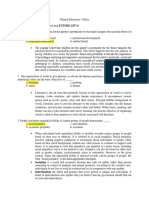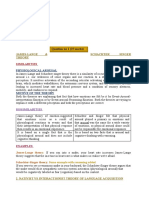TEACHER RECORD MOD 1 Unit 4
TEACHER RECORD MOD 1 Unit 4
Uploaded by
AJ Grean EscobidoCopyright:
Available Formats
TEACHER RECORD MOD 1 Unit 4
TEACHER RECORD MOD 1 Unit 4
Uploaded by
AJ Grean EscobidoCopyright
Available Formats
Share this document
Did you find this document useful?
Is this content inappropriate?
Copyright:
Available Formats
TEACHER RECORD MOD 1 Unit 4
TEACHER RECORD MOD 1 Unit 4
Uploaded by
AJ Grean EscobidoCopyright:
Available Formats
Unit 4: Setting the stage
Seating
One of the best ways of making sure you engage your students and maximise on communication in
the classroom can be as simple as arranging your classroom so that its layout encourages
interaction. Unless you are particularly unlucky, most classrooms, even in the most modest of
schools, will have moveable chairs and/or tables.
Your previous learning experience probably involved sitting at rows of static desks. Human nature
also normally means that on each return visit to the classroom, you’ll sit in the same position in the
classroom. One of our roles as an EFL teacher is to maximise student interaction and increase
confidence in the ability to communicate in English.
A very simple method of achieving this is by thinking about the layout of the classroom. It’s
important to experiment with different seating and standing arrangements to find out what works
best for different tasks such as group activities, pair work and opposing team games.
Whole class discussion: In a horseshoe layout students are able to interact more naturally
because they can see each other. It also ensures that the same students aren’t always
dominating at the front of the class.
Small group work: When students are placed in ‘islands’ they are able to collaborate
effectively, feeling part of a team but are close enough to work with neighbouring groups if
necessary.
Pair work: A traditional seating plan which allows students to work together in twos with the
added advantage that the teacher is able to monitor from the front of the class or by moving
between rows.
Opposing teams: Each team has its own corner which gets students really excited at the
prospect of winning against the ‘enemy’ side; great for getting students participating
wholeheartedly in the task!
A/B role-play: For role-play activities it’s best to have students facing each other rather than
sat side-by-side, this way they focus on their own part of the task rather than trying to work
on the activity as a whole. Another alternative would be to line up all the chairs in two rows
in the centre of the classroom.
Student-led lesson: Much like the horseshoe style, students in the circular layout can make
eye-contact and interact together easily. In this arrangement, however, the teacher is
positioned in the circle with the students, putting them on an equal level and encouraging
the students to lead the class themselves.
You might also like
- The Subtle Art of Not Giving a F*ck: A Counterintuitive Approach to Living a Good LifeFrom EverandThe Subtle Art of Not Giving a F*ck: A Counterintuitive Approach to Living a Good Life4/5 (6054)
- The Gifts of Imperfection: Let Go of Who You Think You're Supposed to Be and Embrace Who You AreFrom EverandThe Gifts of Imperfection: Let Go of Who You Think You're Supposed to Be and Embrace Who You Are4/5 (1142)
- Never Split the Difference: Negotiating As If Your Life Depended On ItFrom EverandNever Split the Difference: Negotiating As If Your Life Depended On It4.5/5 (917)
- Hidden Figures: The American Dream and the Untold Story of the Black Women Mathematicians Who Helped Win the Space RaceFrom EverandHidden Figures: The American Dream and the Untold Story of the Black Women Mathematicians Who Helped Win the Space Race4/5 (946)
- The Hard Thing About Hard Things: Building a Business When There Are No Easy AnswersFrom EverandThe Hard Thing About Hard Things: Building a Business When There Are No Easy Answers4.5/5 (361)
- Devil in the Grove: Thurgood Marshall, the Groveland Boys, and the Dawn of a New AmericaFrom EverandDevil in the Grove: Thurgood Marshall, the Groveland Boys, and the Dawn of a New America4.5/5 (273)
- The World Is Flat 3.0: A Brief History of the Twenty-first CenturyFrom EverandThe World Is Flat 3.0: A Brief History of the Twenty-first Century3.5/5 (2283)
- A Heartbreaking Work Of Staggering Genius: A Memoir Based on a True StoryFrom EverandA Heartbreaking Work Of Staggering Genius: A Memoir Based on a True Story3.5/5 (233)
- MEC713 ProjectManagement MidtermlExam 2013No ratings yetMEC713 ProjectManagement MidtermlExam 20138 pages
- Teaching Profession Lecture July 11 2021 - NoNo ratings yetTeaching Profession Lecture July 11 2021 - No124 pages
- Philosophical Perspective of The SelfpdfNo ratings yetPhilosophical Perspective of The Selfpdf34 pages
- Q1 Q2 Q3 Q4: Days Present Days Absent Days Tardy Days IncompleteNo ratings yetQ1 Q2 Q3 Q4: Days Present Days Absent Days Tardy Days Incomplete3 pages
- Using A Constant Time Delay Procedure To Teach Foundational Swimming Skills To Children With AutismNo ratings yetUsing A Constant Time Delay Procedure To Teach Foundational Swimming Skills To Children With Autism10 pages
- The Real Reason Why TV Is Bad For The KidsNo ratings yetThe Real Reason Why TV Is Bad For The Kids2 pages
- Foster LP#3. Thirteen Moons On Turtle's BackNo ratings yetFoster LP#3. Thirteen Moons On Turtle's Back6 pages
- Answers, Explanations, and References: Zinsser's Microbiology. 20th Ed. Norwalk, Conn: AppleNo ratings yetAnswers, Explanations, and References: Zinsser's Microbiology. 20th Ed. Norwalk, Conn: Apple1 page
- An Analysis of Students' Ability in Writing Caption Through Instagram Cut Rosi Maulina, Asnawi Muslem, and YulianaNo ratings yetAn Analysis of Students' Ability in Writing Caption Through Instagram Cut Rosi Maulina, Asnawi Muslem, and Yuliana9 pages
- Zi-Track Advanced Version Installation & RegistrationNo ratings yetZi-Track Advanced Version Installation & Registration3 pages
- Seminar Topic - Job Description of Departmental Sister0% (1)Seminar Topic - Job Description of Departmental Sister18 pages
- The Clinical Learning Spiral: A Model To Develop Reflective PractitionersNo ratings yetThe Clinical Learning Spiral: A Model To Develop Reflective Practitioners9 pages
- Akers, Ronald L. - Social Learning TheoryNo ratings yetAkers, Ronald L. - Social Learning Theory18 pages
















































































